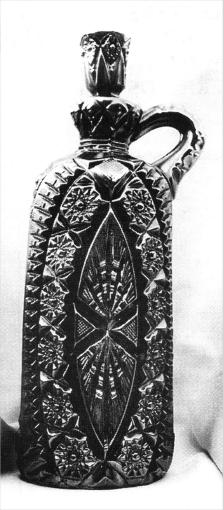Carnival Treasures
by Ruth Eaves
Issue 308 - December 1998
 This exquisite piece of carnival again is from the Woody and Marlene
Punk collection. It is the Wheat Sheaf decanter. The decanter is green
with gold,blue, red, and green highlights in the iridescence. It has a
straight shape and stands 12 inches tall, including the stopper. Its
original purpose was to hold 32 ounces of liquid, according to an old
company catalog.
This exquisite piece of carnival again is from the Woody and Marlene
Punk collection. It is the Wheat Sheaf decanter. The decanter is green
with gold,blue, red, and green highlights in the iridescence. It has a
straight shape and stands 12 inches tall, including the stopper. Its
original purpose was to hold 32 ounces of liquid, according to an old
company catalog.
This rare beauty is the only example known to exist among carnival and Cambridge collectors. The piece was made by the Cambridge Glass Company in Cambridge, Ohio, sometime between 1910 and 1920. I knew very little about the glass made by Cambridge, so I needed to do some research. I contacted Gay Taylor, the curator at The Museum of American Glass at Wheaton Village in Millville, New Jersey. She put me in touch with Bud Walker, a local Cambridge collector.
When I visited Bud and his wife Anna to learn more, I saw many beautiful pieces of Cambridge glass. They were able to answer my questions on the two rare Cambridge decanters. (The second decanter will be featured next newsletter.) I found it interesting to learn they had seen a few of the Wheat Sheaf decanters -- in clear, not carnival -- in their years of collecting. They had not seen another example of a green iridized one. I asked about the "pontil mark" on the bottom and was told it was not a pontil mark since it was not a blown piece of glass. It was mode in a mould with the mould lines being visible on the handle, The piece was made in an upside down position. Visualize a longish mould, hot glass being poured in, then the plunger part of the mould being pushed in to form the void of the decanter. The bottom was the only place wide enough to get the plunger part of the mould in and out. When the plunger was taken out, the bottom of the decanter was open. A glass worker then cut and closed the bottom of the piece, creating that mark in the center of the base that isn't a pontil mark. The type of mould used was called a cut shut mould.
Woody and Marlene bought this piece around 1980. It was originally found at a Cambridge Glass show.
